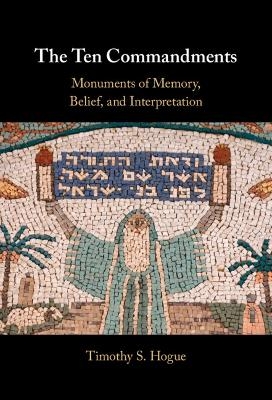
The Ten Commandments
Monuments of Memory, Belief, and Interpretation
Seiten
2023
Cambridge University Press (Verlag)
978-1-009-36689-2 (ISBN)
Cambridge University Press (Verlag)
978-1-009-36689-2 (ISBN)
Connects monumentality and material culture to questions of textual authority and literary history. It includes a comprehensive comparative study of the Decalogue (including new translation and analysis) and Levantine monuments that will be of interest to scholars of Hebrew Bible, Jewish studies, religious studies, archaeology, and art history.
The Decalogue, commonly known as the Ten Commandments, is usually analysed as a text. Within the Hebrew Bible, however, it is depicted as a monument– an artifact embedded in rituals that a community uses to define itself. Indeed, the phraseology, visual representations, and ritual practices of contemporary monuments used to describe the Ten Commandments imbue them with authority. In this volume, Timothy Hogue, presents a new translation, commentary, and literary analysis of the Decalogue through a comparative study of the commandments with inscribed monuments in the ancient Levant. Drawing on archaeological and art historical studies of monumentality, he grounds the Decalogue's composition and redaction in the material culture and political history of ancient Israel and ancient West Asia. Presenting a new inner-biblical reception history of the text, Hogue's book also provides a new model for dating biblical texts that is based on archaeological and historical evidence, rather than purely literary critical methods.
The Decalogue, commonly known as the Ten Commandments, is usually analysed as a text. Within the Hebrew Bible, however, it is depicted as a monument– an artifact embedded in rituals that a community uses to define itself. Indeed, the phraseology, visual representations, and ritual practices of contemporary monuments used to describe the Ten Commandments imbue them with authority. In this volume, Timothy Hogue, presents a new translation, commentary, and literary analysis of the Decalogue through a comparative study of the commandments with inscribed monuments in the ancient Levant. Drawing on archaeological and art historical studies of monumentality, he grounds the Decalogue's composition and redaction in the material culture and political history of ancient Israel and ancient West Asia. Presenting a new inner-biblical reception history of the text, Hogue's book also provides a new model for dating biblical texts that is based on archaeological and historical evidence, rather than purely literary critical methods.
Timothy Hogue is Assistant Professor of Hebrew Bible and Ancient Israelite History in the Department of Near Eastern Languages and Civilizations, University of Pennsylvania.
Introduction: monuments, monumentality, and the Decalogue; 1. Levantine 'I Am' monuments; 2. The Decalogue in the Book of Exodus; 3. The Decalogue in the Book of Deuteronomy; 4. The afterlife of the Decalogue in the postmonarchic period; Conclusion: the monumentality of the Decalogue.
| Erscheinungsdatum | 08.11.2022 |
|---|---|
| Zusatzinfo | Worked examples or Exercises |
| Verlagsort | Cambridge |
| Sprache | englisch |
| Gewicht | 602 g |
| Themenwelt | Religion / Theologie ► Christentum ► Bibelausgaben / Bibelkommentare |
| Religion / Theologie ► Christentum ► Kirchengeschichte | |
| Geisteswissenschaften ► Religion / Theologie ► Judentum | |
| ISBN-10 | 1-009-36689-0 / 1009366890 |
| ISBN-13 | 978-1-009-36689-2 / 9781009366892 |
| Zustand | Neuware |
| Haben Sie eine Frage zum Produkt? |
Mehr entdecken
aus dem Bereich
aus dem Bereich
Buch | Softcover (2021)
De Gruyter (Verlag)
CHF 45,90
wie wir uns unsere spirituelle Heimat zurückholen
Buch | Hardcover (2024)
Patmos Verlag
CHF 27,95


